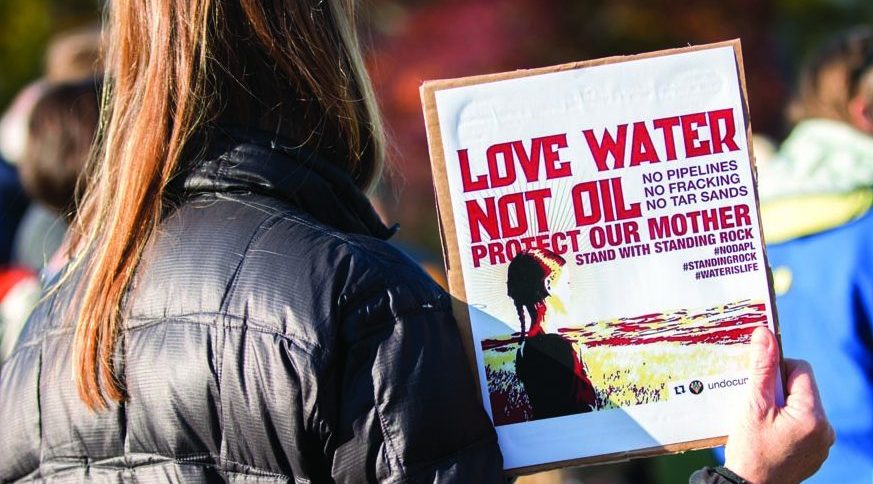For the past few months, the Standing Rock Sioux Tribe has protested the installation of the Dakota Access Pipeline, a $4 billion oil pipeline that would span through four Western states. The pipeline will begin its route in the North Dakota Bakken oil fields, carrying 470 thousand barrels of crude oil per day. The pipeline’s original path ran close to Bismark, N.D., until occupants of the town expressed concern. The pipeline was later moved south of Bismark, and next to the Standing Rock Sioux Tribe’s reservation.
The pipeline will run alongside the Missouri River, the primary source of drinking water for the tribe. Since the early plans of the pipeline’s construction, the tribe has expressed great concern that a spill could become catastrophic to their well-being. Not only could the pipeline potentially contaminate their drinking water, but the construction will also disrupt sacred lands and ancestral burial grounds of the Standing Rock Sioux Tribe.
The Standing Rock Sioux Tribe are members of the Dakota and Lakota nations. The words “Dakota” and “Lakota” translate to “friend” or “allies,” and the latter has become a significant word during months of protest.
In the beginning stages, a member of the tribe put out a plea for help, only expecting 40 or so people to come display their support. Now, over 100 Native American tribes throughout the U.S. have made the journey to offer their support to Standing Rock. For the first time in history, many different tribes have bound together to move forward in unity and solidarity for their future generations.
The site of the different tribes camped out at the protest is eye opening and fills you with a sense of harmony. The hundreds of tribes’ flags are hoisted up into the air, all in connection with one another. The different tribes and protestors bring donations of food and shelter, making it seem like it is a small community.
However, many of the protestors aren’t part of tribes, or even Native American. Shailene Woodley, a Hollywood actress known for her previous work in the “Divergent” series, “The Fault in Our Stars” and the “Snowden” film, has dramatically expressed her stance on the topic. For over a month, she has peacefully protested alongside of Standing Rock and hundreds of other tribes.
On Monday, Oct. 10, she was arrested along with 27 other protesters while blockading the pipeline construction worksite. Footage of the actress getting arrested was streamed live onto her Facebook of 40,000 viewers, helping to spread light on what is occurring at Standing Rock.
Using her celebrity title, she has spoken on behalf of the tribe on many news outlets and talk show interviews. The 25-year-old actress spoke out, saying, “It is a civic responsibility, even me being a non-native to recognize what my ancestors did to the Native Americans in this country and what I refuse to happen to these Native Americans.”
Her statement gleams light on the other occurrences similar to that of Standing Rock. Indigenous people are at the forefront of this fight, and many times they are the ones first affected due to the veil of silence cast over these communities when pipelines are put in.
The most recent inland oil spill to occur in the U.S. resulted in 800 thousand gallons of crude oil leaking into the Kalamazoo River in Michigan. This spill affected 5000 acres of inland habitat, killing animals and contaminating water.
However, the North Dakota Petroleum Company Council declares that spills similar to that of 2010 are highly unlikely to occur at Standing Rock due to the great depth of 90 feet separating the pipeline and the riverbed.
But the members of Standing Rock are not persuaded. They believe that the thousands of gallons of oil flowing under their main source of drinking water is not safe.
Energy Transfer, the company in charge of the production of the pipeline, emphasizes the benefits. Running oil through the ground is a much safer and cost-efficient way of transporting it, rather than on trains or trucks, which have a greater chance of crashing. However, the amount of oil that would spill in a train accident compared to a pipeline spill is significantly less.
The main benefit of the Dakota Access Pipeline is that it will generate revenue and create 8,000 to 12,000 local jobs during the many stages of construction.
David Archambault II, the chairman of the Standing Rock Sioux Tribe has spoken out, saying, “The pipeline is a process that keeps moving forward because of the interest of economic development, the interest of money and the interest of greed.”
The Standing Rock Sioux Tribe and their fellow allies continue to peacefully protest their right to clean drinking water and the right to their sacred land. Their core effort is to lookout for the future, not just for their own tribe, or all the Native Americans, but for all people.
So, do you stand with Standing Rock?
Taylor Tosheff is a fourth-year student majoring in communication studies. She can be reached at TT801606@wcupa.edu.

